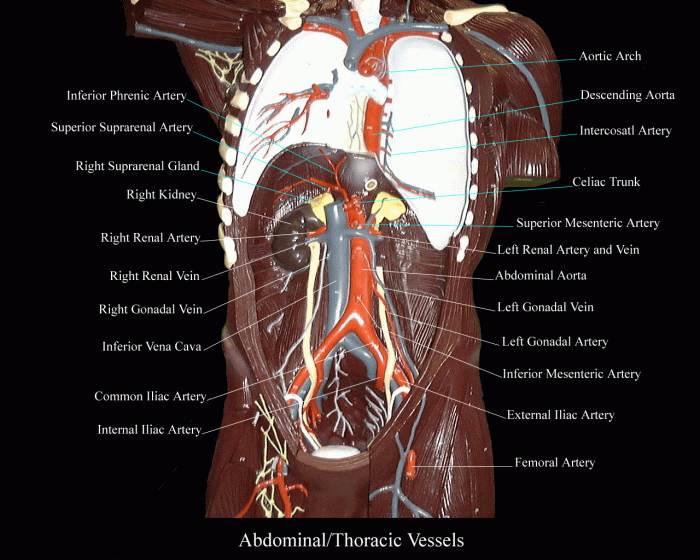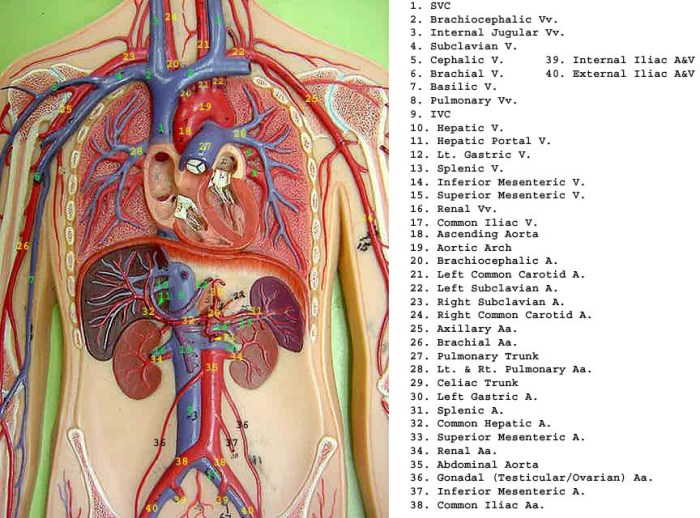Torso model labeled blood vessels – Delving into the realm of torso models labeled with blood vessels, this comprehensive guide unveils the intricacies of human anatomy and its pedagogical applications. These meticulously crafted models serve as invaluable tools for medical education, patient enlightenment, and surgical preparation, offering a tangible representation of the body’s intricate vascular network.
Our journey begins with an exploration of the different types of torso models available, each tailored to specific educational or clinical needs. We will delve into the detailed anatomy of blood vessels, unraveling their precise anatomical locations and the labeling conventions employed to identify them on these models.
Overview of Torso Model Labeled Blood Vessels
A torso model labeled with blood vessels is a three-dimensional representation of the human torso that includes detailed markings and annotations of the major blood vessels. These models are essential educational and clinical tools used to visualize and study the anatomy and physiology of the circulatory system.
There are various types of torso models available, each with specific features and applications. Some models focus on the superficial blood vessels, while others provide a more in-depth view of the deeper vessels and their connections to organs and tissues.
Anatomy and Labeling of Blood Vessels

The major blood vessels in the human torso include the heart, arteries, veins, and capillaries. The heart is the central organ of the circulatory system, pumping oxygenated blood through arteries to various parts of the body and receiving deoxygenated blood from veins.
Arteries carry oxygenated blood away from the heart, while veins carry deoxygenated blood back to the heart. Capillaries are the smallest blood vessels that facilitate the exchange of nutrients, oxygen, and waste products between the blood and surrounding tissues.
Torso models labeled with blood vessels typically use color-coding and anatomical landmarks to identify and differentiate between different types of vessels. Arteries are often depicted in red, veins in blue, and capillaries in purple or pink.
Applications and Uses of Torso Models
Torso models labeled with blood vessels are widely used in medical education, patient education, and surgical planning.
- Medical Education:These models provide students with a tangible and interactive way to study the anatomy and physiology of the circulatory system. They can be used to demonstrate the location, course, and connections of blood vessels, as well as their relationship to other organs and structures.
- Patient Education:Torso models can be used to educate patients about their own anatomy and the specific blood vessels affected by medical conditions or surgical procedures. This can help patients better understand their diagnosis and treatment options.
- Surgical Planning:Torso models can be used by surgeons to plan complex surgical procedures involving blood vessels. They can provide a detailed and accurate representation of the target area, allowing surgeons to visualize the vessels and surrounding structures before making incisions.
Design and Construction of Torso Models

Torso models labeled with blood vessels are typically made of durable materials such as plastic or resin. The blood vessels are meticulously sculpted and labeled, often using a combination of color-coding and anatomical landmarks.
Creating a torso model labeled with blood vessels is a complex process that requires a deep understanding of human anatomy and the circulatory system. It involves carefully sculpting the model, labeling the blood vessels, and ensuring that the model is anatomically accurate and visually appealing.
Comparisons and Contrasts
Different types of torso models labeled with blood vessels vary in terms of size, accuracy, and durability.
| Feature | Small Torso Models | Large Torso Models | Advanced Torso Models |
|---|---|---|---|
| Size | Compact and portable | Larger and more detailed | May include interactive simulations |
| Accuracy | Simplified and stylized | Highly detailed and anatomically accurate | May include virtual reality features |
| Durability | Less durable | More durable | May have enhanced durability for surgical planning |
| Applications | Basic medical education | Advanced medical education, patient education | Surgical planning, research |
Advanced Features and Technologies: Torso Model Labeled Blood Vessels
Some torso models labeled with blood vessels incorporate advanced features and technologies to enhance their educational and clinical value.
- Interactive Simulations:These models allow users to interact with the blood vessels and simulate blood flow, which can provide a more dynamic and engaging learning experience.
- Virtual Reality:Some models integrate virtual reality technology, allowing users to immerse themselves in a virtual environment and explore the circulatory system from different perspectives.
- 3D Printing:Advanced torso models can be 3D printed using medical imaging data, providing highly customized and patient-specific models for surgical planning and education.
Common Queries
What are the different types of torso models labeled with blood vessels?
Torso models vary in size, accuracy, and materials used. Some common types include life-size models, dissectible models, and virtual reality models.
How are blood vessels labeled on torso models?
Blood vessels are typically labeled using color-coding and anatomical landmarks. Arteries are often shown in red, veins in blue, and capillaries in purple.
What are the advantages of using torso models labeled with blood vessels?
These models provide a tangible and interactive way to learn about human anatomy, making them ideal for medical education and patient education.